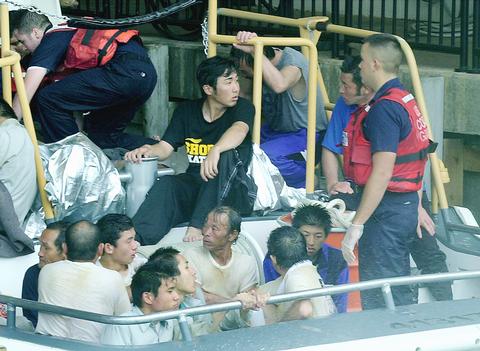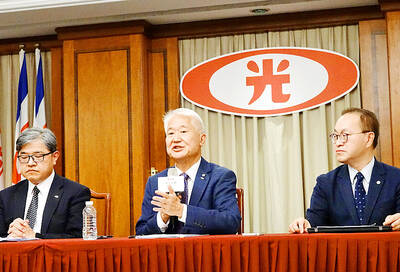Rescue crews held out hope that they would find nine people who were in a Japanese fishing vessel that sank to the bottom of the Pacific Ocean after colliding with a US Navy nuclear-powered attack submarine.
Twenty-six survivors who were stranded amid the debris and covered with diesel fuel from the crash were brought to shore. The boat was carrying high school students who were learning how to fish.
The USS Greeneville came up under the 54m boat, ripping the engine room open and causing two resounding booms. Seconds later, water flooded the vessel, sinking it within minutes, said a coast guard translator describing the Friday collision 14km south of Waikiki.

PHOTO: AP
"Most of the people were below deck in the rooms or galley," said Petty Officer Michael Carr, who interviewed the survivors. "After the lights went out, everyone started yelling that the water was coming into the ship. That's when most of the people we saw started fleeing."
The fishing boat carried 35 people, including 20 crew members, two teachers and 13 students from the Uwajima Fisheries High School in the southwestern Japanese prefecture of Ehime. The missing included four high school students, two teachers and three crew members.
The boat, the Ehime Maru, left Japan on Jan. 10 to hunt for tuna, swordfish and shark.
The navy and coast guard hoped to find people clinging to the wreckage. "We found some debris earlier today, but no sign of survivors yet," said coast guard spokesman Lieutenant Greg Fondran.
The survivors huddled in three life rafts before being rescued. Petty Officer Thomas Kron, who was on the coast guard patrol boat, said the survivors were soaked with diesel fuel that spilled when the boat sank.
"They seemed like they were in shock. They were fatigued by the time we got there," he said. "Some of them were seasick and some of them were glad to see us."
The survivors were taken to the coast guard station at Honolulu Harbor's Sand Island. Some walked off on their own; others were carried on stretchers and covered in blankets.
Fondran said none appeared to be seriously injured. A wounded shoulder appeared to be the worst injury, he said.
Twelve were taken to local hospitals for treatment of minor injuries while 14 were cared for at the base, including showers to wash off the fuel, he said.
Dressed in blue jump suits, the survivors lined up to use the single phone available to them at the base, to let their families in Japan know that they were safe.
Japanese officials said they were scrambling to coordinate a response to the accident.
"It's a bit chaotic right now," said Uwajima municipal official Masanori Mori. "There's a great deal of shock."
Mori said the Ehime Prefectural government had set up a crisis center to assist families and gather information on the accident.

The combined effect of the monsoon, the outer rim of Typhoon Fengshen and a low-pressure system is expected to bring significant rainfall this week to various parts of the nation, the Central Weather Administration (CWA) said. The heaviest rain is expected to occur today and tomorrow, with torrential rain expected in Keelung’s north coast, Yilan and the mountainous regions of Taipei and New Taipei City, the CWA said. Rivers could rise rapidly, and residents should stay away from riverbanks and avoid going to the mountains or engaging in water activities, it said. Scattered showers are expected today in central and

COOPERATION: Taiwan is aligning closely with US strategic objectives on various matters, including China’s rare earths restrictions, the Ministry of Foreign Affairs said Taiwan could deal with China’s tightened export controls on rare earth metals by turning to “urban mining,” a researcher said yesterday. Rare earth metals, which are used in semiconductors and other electronic components, could be recovered from industrial or electronic waste to reduce reliance on imports, National Cheng Kung University Department of Resources Engineering professor Lee Cheng-han (李政翰) said. Despite their name, rare earth elements are not actually rare — their abundance in the Earth’s crust is relatively high, but they are dispersed, making extraction and refining energy-intensive and environmentally damaging, he said, adding that many countries have opted to

People can preregister to receive their NT$10,000 (US$325) cash distributed from the central government on Nov. 5 after President William Lai (賴清德) yesterday signed the Special Budget for Strengthening Economic, Social and National Security Resilience, the Executive Yuan told a news conference last night. The special budget, passed by the Legislative Yuan on Friday last week with a cash handout budget of NT$236 billion, was officially submitted to the Executive Yuan and the Presidential Office yesterday afternoon. People can register through the official Web site at https://10000.gov.tw to have the funds deposited into their bank accounts, withdraw the funds at automated teller

CONCESSION: A Shin Kong official said that the firm was ‘willing to contribute’ to the nation, as the move would enable Nvidia Crop to build its headquarters in Taiwan Shin Kong Life Insurance Co (新光人壽) yesterday said it would relinquish land-use rights, or known as surface rights, for two plots in Taipei’s Beitou District (北投), paving the way for Nvidia Corp to expand its office footprint in Taiwan. The insurer said it made the decision “in the interest of the nation’s greater good” and would not seek compensation from taxpayers for potential future losses, calling the move a gesture to resolve a months-long impasse among the insurer, the Taipei City Government and the US chip giant. “The decision was made on the condition that the Taipei City Government reimburses the related